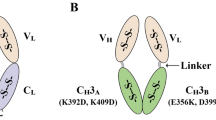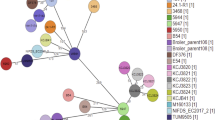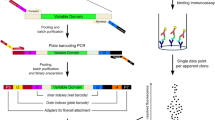Abstract
We have previously demonstrated that the expression of fully functional Fv and Fab fragments in E. coli is possible by the simultaneous secretion of both chains to the periplasm. To increase production levels and facilitate engineering and random mutagenesis, we improved our previous vectors by introducing a resident represser gene and a filamentous phage origin. We also developed a new purification strategy based on immobilized metal ion chromatography, with which a single-chain Fv fragment can be purified to homogeneity in a single step. We investigated the most efficient tail constructions and found that only a minimal structural change of three additional C-terminal amino acids is necessary. This modification has no deleterious effect on in vivo transport and folding or antigen affinity.
This is a preview of subscription content, access via your institution
Access options
Subscribe to this journal
Receive 12 print issues and online access
$259.00 per year
only $21.58 per issue
Buy this article
- Purchase on SpringerLink
- Instant access to full article PDF
Prices may be subject to local taxes which are calculated during checkout
Similar content being viewed by others
References
Skerra, A. and Plückthun, A. 1988. Assembly of a functional immu-noglobulin Fv fragment in Escherichia coli. Science 240: 1038–1041.
Plückthun, A. and Skerra, A. 1989. Expression of functional antibody Fv and Fab fragments in E. coli. Meth. Enzymol. 178: 497–515.
Ward, E.S., Güssow, D., Griffiths, A.D., Jones, P.T. and Winter, G. 1989. Binding activities of a repertoire of single immunoglobulin variable domains secreted from Escherichia coli. Nature 341: 544–546.
Huse, W.D., Sastry, L., Iverson, S.A., Kang, A.S., Alting-Mees, M., Burton, D.R., Benkovic, S.J. and Lerner, R.A. 1989. Generation of a large combinatorial library of the immunoglobulin repertoire in phage lambda. Science 246: 1275–1281.
Potter, M. 1977. Antigen-binding myeloma proteins of mice. Adv. Immunol. 25: 141–211.
Perlmutter, R.M., Crews, S.T., Douglas, R., Sorensen, G., Johnson, N., Nivera, N., Gearhart, P.J. and Hood, L. 1984. The generation of diversity in phosphorylcholine-binding antibodies. Adv. Immunol. 35: 1–37.
Leon, M.A. and Young, N.M. 1971. Specificity for phosphorylcholine of six murine myeloma proteins reactive with Pneumococcus C polysac-charide and β-lipoprotein. Biochemistry 10: 1424–1429.
Young, N.M. and Leon, M.A. 1977. The binding of analogs of phosphorylcholine by the murine myeloma proteins McPC603, MOPC167 and S107. Immunochemistry 14: 757–761.
Metzger, H., Chesebro, B., Hadler, N.M., Lee, J. and Otchin, N. 1971. Modification of immunoglobulin combining sites, p. 253–267. In: Progress in Immunology: Proceedings of the 1st Congress of Immunology. Amos, B. (Ed.). Academic Press, New York.
Segal, D.M., Padlan, E.A., Cohen, G.H., Rudikoff, S., Potter, M. and Davies, D.R. 1974. The three-dimensional structure of a phosphorylcholine-binding mouse immunoglobulin Fab and the nature of the antigen binding site. Proc. Nat. Acad. Sci. USA 71: 4298–4302.
Satow, Y., Cohen, G.H., Padlan, E.A. and Davis, D.R. 1986. Phosphocholine binding immunoglobulin Fab McPC603. J. Mol. Biol. 90: 593–604.
Glockshuber, R., Malia, M., Pfitzinger, I. and Pluckthun, A. 1990. A comparison of strategies to stabilize immunoglobulin Fv fragments. Biochemistry 29: 1362–1367.
Bird, R.E., Hardman, K.D., Jacobson, J.W., Johnson, S., Kaufman, B.M., Lee, S.M., Lee, T., Pope, S.H., Riordan, G.S. and Whitlow, M. 1988. Single-chain antigen-binding proteins. Science 242: 423–426.
Huston, J.S., Levinson, D., Mudgett-Hunter, M., Tai, M.S., Novotny, J., Margolies, M.N., Ridge, R.J., Bruccoleri, R.E., Haber, E., Crea, R. and Oppermann, H. 1988. Protein engineering of antibody binding sites: Recovery of specific activity in an anti-digoxin single-chain Fv analogue produced in Escherichia coli. Proc. Nat. Acad. Sci. USA 85: 5879–5883.
Smith, M.C., Furman, T.C. and Pidgeon, C. 1987. Immobilized iminodiacetic acid metal peptide complexes. Identification of chelating peptide purification handles for recombinant proteins, Inorg. Chem. 26: 1965–1969.
Smith, M.C., Furman, T.C., Ingolia, T.D. and Pidgeon, C. 1988. Chelating peptide-immobilized metal ion affinity chromatography. J. Biol. Chem. 263: 7211–7215.
Hochuli, E., Bannwarth, W., Döbeli, H., Gentz, R. and Stüber, D. 1988. Genetic approach to facilitate purification of recombinant proteins with a novel metal chelate adsorbent. Bio/Technology 6: 1321–1325.
Hochuli, E., Döbeli, H. and Schacher, A. 1987. New metal chelate adsorbent selective for proteins and peptides containing neighbouring histidine residues. J. Chromatography 411: 177–184.
Ghrayeb, J., Kimura, H., Takahara, M., Hsiung, H., Masui, Y. and Inouye, M. 1984. Secretion cloning vectors in Escherichia coli. EMBO J. 3: 2437–2442.
Schoner, B.E., Belagaje, R.M. and Schoner, R.G. 1990. Enhanced translational efficiency with two-cistron expression system. Methods Enzymol. 185: 94–114.
Nakamura, K., Pirtle, R.M., Pirtle, I.L., Takeishi, K. and Inouye, M. 1980. Messenger ribonucleic acid of the lipoprotein of the Escherichia coli outer membrane. J. Biol. Chem. 255: 210–216.
Yanisch-Perron, C., Vieira, J. and Messing, J. 1985. Improved M13 phage cloning vectors and host strains: Nucleotide sequences of the M13mpl8 and pUC19 vectors. Gene 33: 103–119.
Geisselsoder, J., Witney, F. and Yuckenberg, P. 1987. Efficient site-directed in vitro mutagenesis. Biotechniques 5: 786–791.
Kunkel, T.A., Roberts, J.D. and Zakour, R.A. 1987. Rapid and efficient site-specific mutagenesis without phenotypic selection. Methods Enzymol. 154: 367–382.
Sassenfeld, H.M. and Brewer, S.J. 1984. A polypeptide fusion designed for the purification of recombinant proteins. Bio/Technology 2: 76–81.
von Heijne, G. 1989. Control of topology and mode of assembly of a polytopic membrane protein by positively charged residues. Nature 341: 456–458.
Summers, R.G., Harris, C.R. and Knowles, J.R. 1989. A conservative amino acid substitution, arginine for lysine, abolishes export of a hybrid protein in Escherichia coli. J. Biol. Chem. 264: 20082–20088.
Sassenfeld, H.M. 1990. Engineering proteins for purification. Trends Biotechnol. 888–93.
Ljungquist, C., Breitholtz, A., Brink-Nilsson, H., Moks, T., Uhlén, M. and Nilsson, B. 1989. Immobilization and affinity purification of recombinant proteins using histidine peptide fusions. Eur. J. Biochem. 186: 563–569.
Vieira, J. and Messing, J. 1982. The pUC plasmids, an M13mp7-derived system for insertion mutagenesis and sequencing with synthetic universal primers. Gene 19: 259–268.
Vieira, J. and Messing, J. 1987. Production of single-stranded plasmid DNA. Methods Enzymol. 153: 3–11.
Takagi, H., Morinaga, Y., Tsuchiya, M., Ikemura, H. and Inouye, M. 1988. Control of folding of proteins secreted by a high expression secretion vector, pIN-III-ompA: a 16-fold increase in production of active subtilisin E in Escherichia coli. Bio/Technology 6: 948–950.
Stark, M.J.R. 1987. Multicopy expression vectors carrying the lac represser gene for regulated high-level expression of genes in Escherichia coli. Gene 51: 255–267.
Maniatis, T., Fritsch, E.F. and Sambrook, J. 1982. Molecular Cloning: A Laboratory Manual. Cold Spring Harbor Laboratory, New York.
Beck, E. and Zink, B. 1981. Nucleotide sequence and genome organisation of filamentous bacteriophages f1 and fd. Gene 16: 35–58.
Chesebro, B. and Metzger, H. 1972. Affinity labeling of a phosphorylcholine binding mouse myeloma protein. Biochemistry 11: 766–771.
Author information
Authors and Affiliations
Rights and permissions
About this article
Cite this article
Skerra, A., Pfitzinger, I. & Plückthun, A. The Functional Expression of Antibody Fv Fragments in Ischhuchia coli: Improved Vectors and a Generally Applicable Purification Technique. Nat Biotechnol 9, 273–278 (1991). https://doi.org/10.1038/nbt0391-273
Received:
Accepted:
Issue date:
DOI: https://doi.org/10.1038/nbt0391-273
This article is cited by
-
Systematic screening of soluble expression of antibody fragments in the cytoplasm of E. coli
Microbial Cell Factories (2016)
-
Efficient production of soluble recombinant single chain Fv fragments by a Pseudomonas putida strain KT2440 cell factory
Microbial Cell Factories (2011)
-
Single chain Fab (scFab) fragment
BMC Biotechnology (2007)
-
Production of single chain Fab (scFab) fragments in Bacillus megaterium
Microbial Cell Factories (2007)
-
Construction of expression vectors and study on single-chain antibody and reshaping single-domain antibody against CD3
Science in China Series C: Life Sciences (1997)



